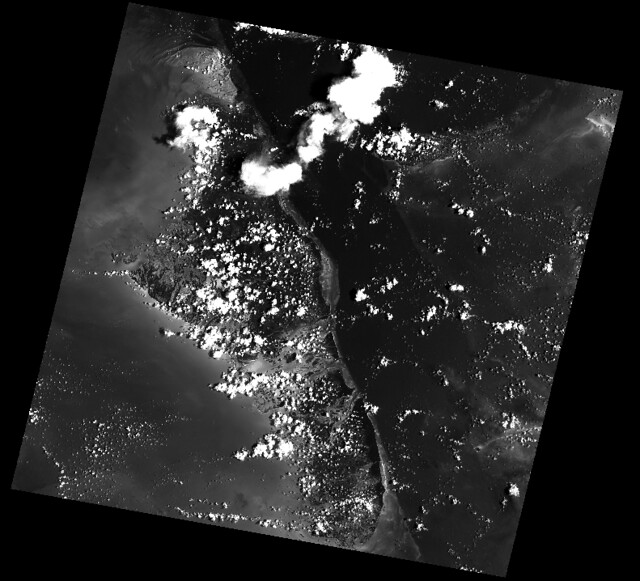Fast and direct raster I/O for Python programmers who use Numpy
Project description
Rasterio reads and writes geospatial raster datasets.

Rasterio employs GDAL under the hood for file I/O and raster formatting. Its functions typically accept and return Numpy ndarrays. Rasterio is designed to make working with geospatial raster data more productive and more fun.
Rasterio is pronounced raw-STIER-ee-oh.
Example
Here’s a simple example of the basic features rasterio provides. Three bands are read from an image and summed to produce something like a panchromatic band. This new band is then written to a new single band TIFF.
import numpy
import rasterio
import subprocess
# Register GDAL format drivers and configuration options with a
# context manager.
with rasterio.drivers(CPL_DEBUG=True):
# Read raster bands directly to Numpy arrays.
#
with rasterio.open('tests/data/RGB.byte.tif') as src:
b, g, r = src.read()
# Combine arrays in place. Expecting that the sum will
# temporarily exceed the 8-bit integer range, initialize it as
# 16-bit. Adding other arrays to it in-place converts those
# arrays "up" and preserves the type of the total array.
total = numpy.zeros(r.shape, dtype=rasterio.uint16)
for band in r, g, b:
total += band
total /= 3
# Write the product as a raster band to a new 8-bit file. For
# keyword arguments, we start with the meta attributes of the
# source file, but then change the band count to 1, set the
# dtype to uint8, and specify LZW compression.
kwargs = src.meta
kwargs.update(
dtype=rasterio.uint8,
count=1,
compress='lzw')
with rasterio.open('example-total.tif', 'w', **kwargs) as dst:
dst.write_band(1, total.astype(rasterio.uint8))
# At the end of the ``with rasterio.drivers()`` block, context
# manager exits and all drivers are de-registered.
# Dump out gdalinfo's report card and open the image.
info = subprocess.check_output(
['gdalinfo', '-stats', 'example-total.tif'])
print(info)
subprocess.call(['open', 'example-total.tif'])
The rasterio.drivers() function and context manager are new in 0.5. The example above shows the way to use it to register and de-register drivers in a deterministic and efficient way. Code written for rasterio 0.4 will continue to work: opened raster datasets may manage the global driver registry if no other manager is present.
API Overview
Simple access is provided to properties of a geospatial raster file.
with rasterio.drivers():
with rasterio.open('tests/data/RGB.byte.tif') as src:
print(src.width, src.height)
print(src.crs)
print(src.affine)
print(src.count)
print(src.indexes)
# Output:
# (791, 718)
# {u'units': u'm', u'no_defs': True, u'ellps': u'WGS84', u'proj': u'utm', u'zone': 18}
# Affine(300.0379266750948, 0.0, 101985.0,
# 0.0, -300.041782729805, 2826915.0)
# 3
# [1, 2, 3]Rasterio also affords conversion of GeoTIFFs to other formats.
with rasterio.drivers():
rasterio.copy(
'example-total.tif',
'example-total.jpg',
driver='JPEG')
subprocess.call(['open', 'example-total.jpg'])Rasterio CLI
Rasterio’s command line interface, named “rio”, is documented at cli.rst. Its rio insp command opens the hood of any raster dataset so you can poke around using Python.
$ rio insp tests/data/RGB.byte.tif
Rasterio 0.10 Interactive Inspector (Python 3.4.1)
Type "src.meta", "src.read_band(1)", or "help(src)" for more information.
>>> src.name
'tests/data/RGB.byte.tif'
>>> src.closed
False
>>> src.shape
(718, 791)
>>> src.crs
{'init': 'epsg:32618'}
>>> b, g, r = src.read()
>>> b
masked_array(data =
[[-- -- -- ..., -- -- --]
[-- -- -- ..., -- -- --]
[-- -- -- ..., -- -- --]
...,
[-- -- -- ..., -- -- --]
[-- -- -- ..., -- -- --]
[-- -- -- ..., -- -- --]],
mask =
[[ True True True ..., True True True]
[ True True True ..., True True True]
[ True True True ..., True True True]
...,
[ True True True ..., True True True]
[ True True True ..., True True True]
[ True True True ..., True True True]],
fill_value = 0)
>>> b.min(), b.max(), b.mean()
(1, 255, 44.434478650699106)Dependencies
C library dependecies:
GDAL 1.9+
Python package dependencies (see also requirements.txt):
affine
Numpy
setuptools
Development also requires (see requirements-dev.txt)
Cython
pytest
Installation
Rasterio is a C extension and to install on Linux or OS X you’ll need a working compiler (XCode on OS X etc). You’ll also need Numpy preinstalled; the Numpy headers are required to run the rasterio setup script. Numpy has to be installed (via the indicated requirements file) before rasterio can be installed. See rasterio’s Travis configuration for more guidance.
Linux
The following commands are adapted from Rasterio’s Travis-CI configuration.
$ sudo add-apt-repository ppa:ubuntugis/ppa
$ sudo apt-get update -qq
$ sudo apt-get install python-numpy libgdal1h gdal-bin libgdal-dev
$ pip install -r https://raw.githubusercontent.com/mapbox/rasterio/master/requirements.txt
$ pip install rasterioAdapt them as necessary for your Linux system.
OS X
Wheels are available on PyPI for Homebrew based Python environments.
$ brew install gdal
$ pip install -r https://raw.githubusercontent.com/mapbox/rasterio/master/requirements.txt
$ pip install rasterioThe wheels are incompatible with MacPorts. MacPorts users will need to specify a source installation instead: pip install --no-use-wheel.
Windows
Windows binary packages created by Christoph Gohlke are available here.
Testing
From the repo directory, run py.test
$ py.testDocumentation
License
See LICENSE.txt
Changes
See CHANGES.txt
Project details
Release history Release notifications | RSS feed
Download files
Download the file for your platform. If you're not sure which to choose, learn more about installing packages.
Source Distribution
File details
Details for the file rasterio-0.14.1.tar.gz.
File metadata
- Download URL: rasterio-0.14.1.tar.gz
- Upload date:
- Size: 780.4 kB
- Tags: Source
- Uploaded using Trusted Publishing? No
File hashes
| Algorithm | Hash digest | |
|---|---|---|
| SHA256 | a81f8a421c3b778382017b3993057c7486ed88bfb9dff5a246cb50a6e01dfb3a |
|
| MD5 | f8e5722060ecbe019bacf96d877f1e73 |
|
| BLAKE2b-256 | 6900c854d1fbfe3d814b388798acf9589fe9a2650f44b63ace93b4fb82777d29 |











